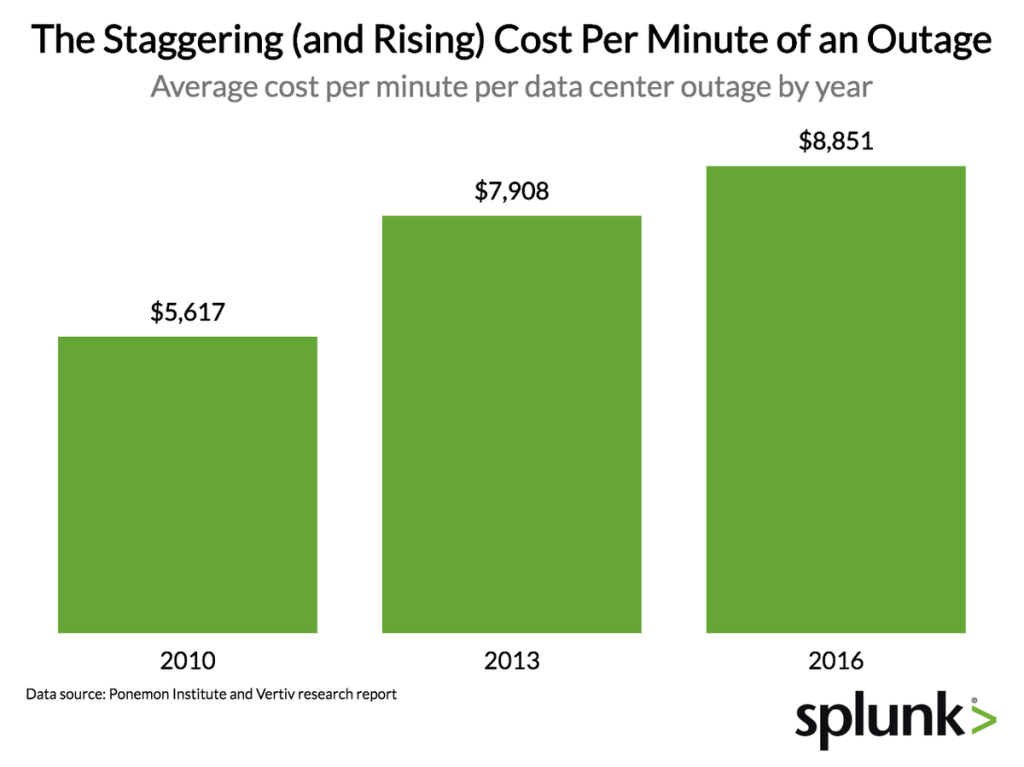Long lines start to queue up and eventually either people leave the line to go to Adidas or decide they simply don’t need a new pair of shoes. Nike earned nearly $4M every hour of every day in 2018. In the retail space, Amazon earned over $258B in gross revenue, equating to nearly $500K each minute. Should Amazon’s website go down, or Nike’s point of sale systems fail for even just a few minutes, hundreds of thousands of dollars in revenue are lost. Therefore, Amazon, Nike, and thousands of companies like them go to great lengths to minimize these outages.

The IT Operations or IT Services industry is a massive trillion-dollar marketand a large portion of the activity in this market goes towards collecting and analyzing the enormous amount of data generated by systems in real-time. Every Nike item purchased online, in apps, or in stores generates an incredibly large number of data points and information which includes date, time, location, as well as log lines that record operating-system level and other technical events. Now imagine thousands of orders online, in apps and in stores per day with customers and stores distributed around the world, and you can see why pinpointing where and why a system outage occurred can be a bit of a needle-in-a-haystack exercise — and effectively impossible for a human to accomplish.
Historically, the majority of this data was not being captured or aggregated, much less analyzed. Recently, companies like Splunk ($19B market cap), Elastic ($6B), New Relic ($4B), Sumo Logic (~$2B), and Datadog (~$7B) all emerged and created an industry around APM, Logs Metrics, and artificial intelligence for IT operations (AIOps) which is projected to reach $11B by 2025. Splunk, Elastic, New Relic, Sumo Logic and Datadog all collect and aggregate massive amounts of data collected from various IT operations tools and devices and use machine learning and advanced analytics to find patterns in that data to ultimately identify potential performance and security issues before they occur.
The majority of these APM, Logs, Metrics, and AIOps companies are collecting this data from various systems and typically centralizing it in the cloud where the data is then analyzed. As this data continues to grow exponentially, bottlenecks and technical limitations create a host of timing and data security issues. Additionally, many of these pricing models are based on consumption, thus the more data analyzed, the more expensive the service becomes to the customer. This leaves a big opportunity to create an edge-based AIOps model that processes data at the source, leaving the limitations of centralized behind.
AIOps on the Edge
There are three massive trends in computing that will drive the AIOps edge market: the move to edge computing, the rise of IoT, and the growth of big data. The articles below point to an IoT future dominated by billions of edge devices. Nearly every business will have the need for an edge computing strategy — collecting data from these billions of devices and sensors that will inform, and in some cases, drive their business. Additionally, we are in the era of big data and the need to collect and process this data in a fast and economical manner will be of supreme importance. This large shift in computing will give rise to the need for edge-based AIOps services.
- By 2020, approximately 50% of enterprises will actively use AIOps technologies together with APM to provide insight into both business execution and IT operations, up from fewer than 10% today. (Gartner)
- “The key function of AIOps platform is to refine traditional IT tools and processes which are out of sync with today’s industry demands. Current business needs require enterprises to move away from siloed databases, tools and lack of interoperability to cut down on costs and manage shifting budgets.” (Analytics India Magazine)
- HPE is among several companies making sizable investments in this new type of computing architecture, in which data is processed and analyzed on or near the device where it’s generated, instead of first being sent to a corporate cloud or data center. (WSJ)
- Total spending on IT, including data center systems, enterprise software and connected devices is expected to reach $4 trillion in 2021, up from $3.4 trillion in 2015, according to Gartner. (WSJ)
- Return to the Edge and the End of Cloud Computing (Peter Levine / A16Z Presentation)
Investing in Edge Delta
This is what led to our excitement at MaC Venture Capital around Edge Delta, and we are proud to announce that we have led their seed round, investing alongside Amity Ventures.
Seattle-based Edge Delta is an Artificial Intelligence for Operations (AIOps) platform that analyzes machine data in real time using federated learning(analysis at the edge). Their platform provides advanced analytics for detecting anomalies in operational and security data. Edge Delta Federated Learning systems can analyze this data with significantly more sophistication, accuracy and orders of magnitude more speed than traditional centralized systems, often at a much lower TCO.

The Edge Delta team could not be more suited to take advantage of these large market opportunities. Co-Founder and CEO, Ozan Unlu previously spent nearly five years at Sumo Logic where he was a top 1% Enterprise Sales Manager selling to over 250 clients in that time. It was his time at Sumo Logic seeing the clear demand from his clients for an edge-based AIOps alternative solution that led him to start Edge Delta. His Co-Founder and CTO Fatih Yildiz spent six years at Twitter and seven years at Microsoft (where he and Ozan met as developers).

See You On the Edge
In summary, the rise of billions of connected devices and infrastructure making up complex and intertwined systems all generating data at the edge will drive the need for IT operations that can collect, analyze and facilitate decisions on that data in real-time. Edge Delta is poised to be a market leader in this future for the reasons below:
- Reducing System Outages: System outages — even ones that last seconds — can result in cascading effects and millions of dollars in missed revenue. Edge Delta helps to minimize these outages.
- Privacy and Security: We have seen many organizations, even those that are considered amongst the most sophisticated tech companies in the world, announce breaches and accidental exposing of sensitive data sets. With Edge Delta processing all raw data at the edge — the potential for damaging incidents is drastically reduced.
- Analysis of More Data: Processing data at the edge vs requiring centralization allows companies to process significantly more data as it is no longer prohibitively expensive to do so. This MIT article states that only 5% of data currently being collected is being processed. Edge Delta makes it economical to process vastly more amounts of data.
- Cost Savings: Processing data at the edge allows for optimizations (bandwidth, storage, compute, etc) leading to less expensive and faster processing than requiring centralization.
- Rise of the Edge and IoT: There is a general consensus around the coming explosion of edge computing where billions of devices will be emitting data that needs to be analyzed to derive insights.
- Edge Delta Team: Ozan has always been a trusted advisor and passionately jumped at the opportunity to serve customer needs in a way not being currently met by existing technologies. He has the unique perspective to notice this gap in the market and serve it. Fatih is a top software engineer with over 15 years of experience at leading tech companies. These two founders have a long personal and professional history and continue to work extremely well together.
We are pleased to be supporting such a phenomenal team working to solve this multi-billion dollar problem.
Originally published by Adrian Fenty and Mike Palank on the MaC Venture Capital website.






